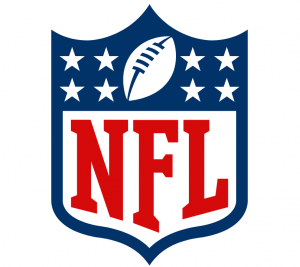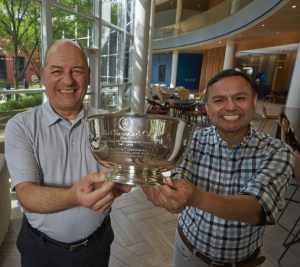By Courtney Ryan
In 1991, the Dallas Cowboys football team ended a 9-year slump by winning their first National Football League (NFL) playoff game since 1982. In the following season, they were crowned Super Bowl champions and returned to win the next year and then again only 2 years later. Now an NFL dynasty, the Cowboys continued to dominate the NFC East division for much of the nineties. Their greatest legacy, though, might be how they altered how every team in the NFL trades picks during the annual draft, for better or worse.
The draft is a market mechanism designed to promote competitive balance; the NFL assigns draft positions to teams in reverse order relative to last season’s performance. The draft proceeds through seven rounds. In each round, each team owns the right to pick one rookie player at their assigned position. Teams can trade their assigned draft picks for other picks and/or players. From 2002 to 2021, 39% of draft picks were traded.
What is the Chart?
The NFL draft pick value chart, often referred to as “the Chart,” was first conceived in 1991 by Cowboys minority owner Mike McCoy. He wanted a handy way to assign a numerical value to each NFL draft pick so the team could better strategize how to pick players and trade draft picks. After analyzing trade patterns from the previous 4 years, he plotted out a steep graph that assigned 3,000 points to the first pick and 2 points to the last. This way, when the Cowboys made trades, they matched the overall points value. Given the team’s sustained success, the model appeared to work.
 When teams vying for a playoff spot hired Cowboys’ staff to help capture their success, they quickly adopted the Chart, which by 2004 had become the gold standard for all draft trade negotiations. But what if the Chart was wrong? Michael Lapré, Associate Professor of Operations Management at Vanderbilt Business, decided it was time someone launched an empirical investigation.
When teams vying for a playoff spot hired Cowboys’ staff to help capture their success, they quickly adopted the Chart, which by 2004 had become the gold standard for all draft trade negotiations. But what if the Chart was wrong? Michael Lapré, Associate Professor of Operations Management at Vanderbilt Business, decided it was time someone launched an empirical investigation.
Why hasn’t this been studied?
While teaching the NFL draft pick value chart during a Vanderbilt MBA elective course on sports analytics, Lapré had an epiphany. “It occurred to me that somebody should actually test if this works,” he said. “And then I thought, ‘I am going to test this!’”
Given that the NFL has grown to a $15 billion business and a Super Bowl broadcast attracts around 100 million viewers, it might seem odd that no one had formally challenged one of the league’s most entrenched recruitment tools before now. But Lapré, who studies organizational learning curves, was not surprised.
“This happens a lot in organizations—people don’t like to challenge the status quo. Many organizations are focused on today and tomorrow. Rarely do they take the opportunity to learn from their own long, rich histories,” he explained.
However, the results of the study, “Does Draft Currency Promote Competitive Balance? An Empirical Investigation of the National Football League 2002–2021,” co-authored by Elizabeth M. Palazzolo (BA’22) and published in the Journal of Sports Economics, suggests that challenging the status quo is exactly what competitive NFL teams should do.
Research method and findings
Lapré and Palazzolo analyzed data for every draft and NFL game played from 1998 through 2021 to empirically investigate whether the NFL draft promotes competitive balance. To study a range of draft-value curves, they created 2 measures: original draft currency, or the total value of picks before any trades, and final draft currency, or the total value of picks after the teams had made their trades. If the Chart was as effective as promised, then the original draft currency should positively impact a team’s chances of making the playoffs.
Instead, the researchers found that the original draft currency had no impact on whether a team made it to the playoffs. Alternatively, the final draft currency does have a positive impact, but with a delay, as it takes a few years for draft picks to develop.
“It’s really how teams trade that affects whether the draft will have an impact on making it to the playoffs or not,” explained Lapré, adding that some teams appear to understand that they can out-trade other teams by using a less steep draft-value curve than is indicated by the Chart.
For example, the New England Patriots were the strongest overall team during the studied period. Despite having the least original draft currency over the same period, they made strategic trades and stockpiled undervalued picks. The Patriots ended up with more final draft currency valued by a less steep draft-value curve than 21 other teams, allowing them to remain among the strongest teams over 20 years. The mechanism of the draft is not necessarily flawed. Instead, other teams’ perceived value of draft picks perpetuates competitive imbalance.

Michael Lapré (left) and Gilbert Gonzales (right) smile while holding the Chancellor’s Cup in the lobby of Vanderbilt Business. Photo by Vanderbilt University.
Implications
Lapré and Palazzolo’s research demonstrates the folly of relying on institutional norms instead of empirically analyzing the available data. NFL teams that still use the Cowboys’ trade value chart have not duplicated the team’s success in the nineties. Instead, they’ve fallen behind more innovative teams like the Patriots. But that doesn’t mean they can’t still improve the league’s competitive balance.
“The NFL needs to come together and agree to shift to a draft-value curve with a less steep decline than McCoy’s original pick value chart,” said Lapré.
More about Michael Lapré
Lapré was awarded the Chancellor’s Cup by Vanderbilt Chancellor Daniel Diermeier for the 2023-2024 year. He is an expert in learning curves, organizational learning, and sports analytics. He has studied quality, productivity, customer dissatisfaction, service failure, bankruptcy, race wins, and competitive imbalance. His industry studies include steel-cord manufacturing, U.S. airlines, Formula One racing, the FIFA Women’s and Men’s World Cup, and the National Football League.